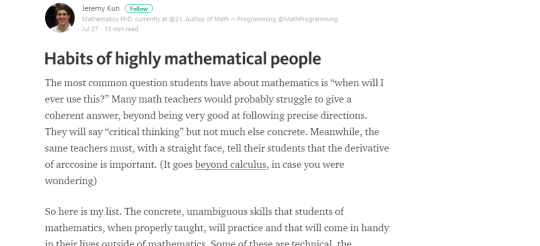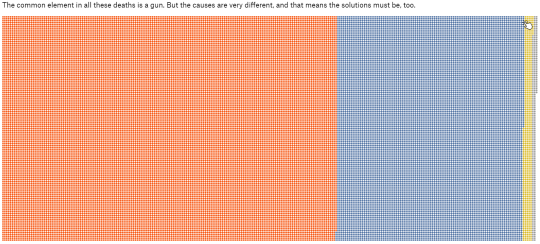

This thought-provoking blog post accurately describes one of the most important reasons for mathematical (and other) education: for the habits of thought and not always only for the content.
Numeracy, and a numerate approach to understanding the world, becomes a habit also. Keep asking: “is that a big number?”

This video recreates the classic “Powers of Ten” film, zooming out to larger and larger scales to the limits of our understanding of the universe, and then zooming in again, down to the smallest things we know about.
It’s an excellent way of illustrating relative magnitudes of distance. One gripe: it all happens a bit too quickly: try watching it at half speed.

Powerful infographic from the FiveThirtyEight.com website (to whom all respect for numbers-led analysis and comment). Gives the question some context and perspective. And #ContextMatters. (Red dots are suicides, blue are homicides, yellow are accidents)
Overall, 33,000 people a year die from shootings in the USA. That IS a big number.

IsThatABigNumber.com is about extending our number sense. We make comparisons that are (mostly) down-to-earth: populations of people and animals, national budgets, river lengths and so on.
But when we leave behind everyday experience and look at the kind of numbers you find in astronomy and in combinatorics, we come across vastly bigger numbers.
One strategy to grasp these numbers is to break them down into a series of levels, to see them as stupidly big aggregations of things that are themselves stupidly big aggregations of … Here are some good clips illustrating this:

The whole point of ThatABigNumber.com is to make numbers easy to grasp, so it needs a way of talking about numbers that is both precise and close to our natural way of expressing ourselves.
This article explains the thinking behind the choices we made.
By and large we are adapted to a world of small differences and steady growth. We are comfortable with difference being a matter of subtraction. But when we stumble over exponential change, differences won’t do. Things have gone Non-Linear.

In 1982 Douglas Hofstadter wrote about Number Numbness. We’re still befuddled in the face of millions and billions, let alone trillions or even bigger numbers.
That’s the reason for IsThatABigNumber.com: to help anyone develop their number sense by putting big numbers in context and providing meaningful comparisons.